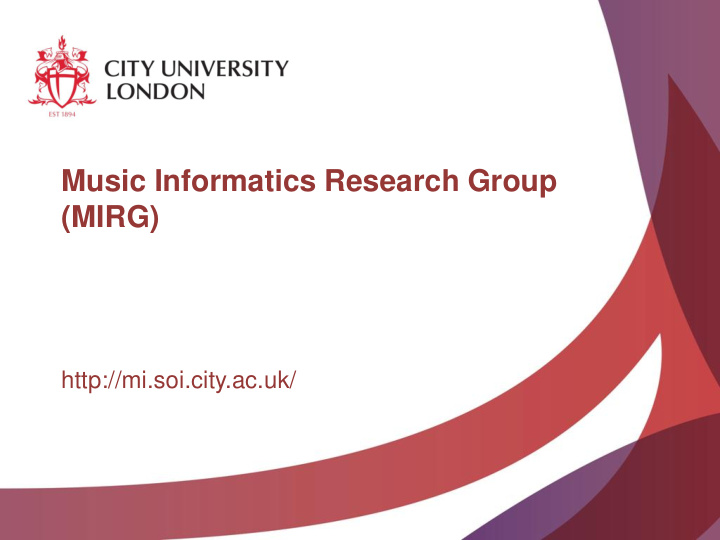



Music Informatics Research Group (MIRG) http://mi.soi.city.ac.uk/
Music Informatics Research Group (MIRG) • Formed in 2005 (succeeded the “ Centre for Computational Creativity ” ) • Members: – Tillman Weyde (Group leader & Senior lecturer) – Emmanouil Benetos (Research fellow) – Daniel Wolff (Research student) – Reinier DeValk (Research student) – Srikanth Cherla (Research student) – Andreas Jansson (Research student) – Olivier Ruello (Intern) – Antoine Winckels (Intern)
Music Informatics Research Group (MIRG) • Research Activities: – Music information retrieval – Music signal analysis – Computational musicology – Music knowledge representation – Applications • Funding: – I-MAESTRO – SLICKMEM
Music Signal Analysis • Multi-pitch detection, instrument identification, source separation... • Application: automatic music transcription • Example: Original audio: Synthesized transcription:
Recognition of polyphonic structure and automatic transcription of lute tablature Lute tablature: no indication of polyphonic structure Extraction of individual voices using machine learning techniques Transcription into modern music notation
Music Analysis & Prediction with Neural Networks • Statistical & probabilistic views on music cognition • Music, cognitive science and machine learning • Understanding – Similarity & Style – Creativity – Familiarity and Preference Image Courtesy, en.wikipedia.org • Music generation Generative music example:
Modelling Melodic Similarity Wavelet Representation for Classification • Mathematical models for analysing signals • Allows for analysis at different time-scales • Works well for recognising similar melodic fragments
Representing Musical Structure in the Semantic Web Sequences in Description Logic: SEQ representation for • sequences (melodies, chord progressions) in description logic SEQ ontology in OWL • • Extends semantic music search and reasoning
Music Similarity Modelling Music Similarity • Complex concept but important for music recommendation and retrieval • Depends on many factors • context, culture, psychoacoustics ... Computational Similarity Models • Weight different aspects of music: – Which features are important? – Music perception + Musicology
Data Collection with Games (With A Purpose) mi.soi.city.ac.uk/camir/game/
Data Collection with Games (With A Purpose) mi.soi.city.ac.uk/camir/game/
Data Collection with Games (With A Purpose) mi.soi.city.ac.uk/camir/game/
Collaborators welcome! We would like to keep in touch with: • App developers - interesting app ideas • Musicians - creative feedback • Educators - explore application to music education • Researchers - technical suggestions and discussion Visit http://mi.soi.city.ac.uk for more info
Recommend
More recommend